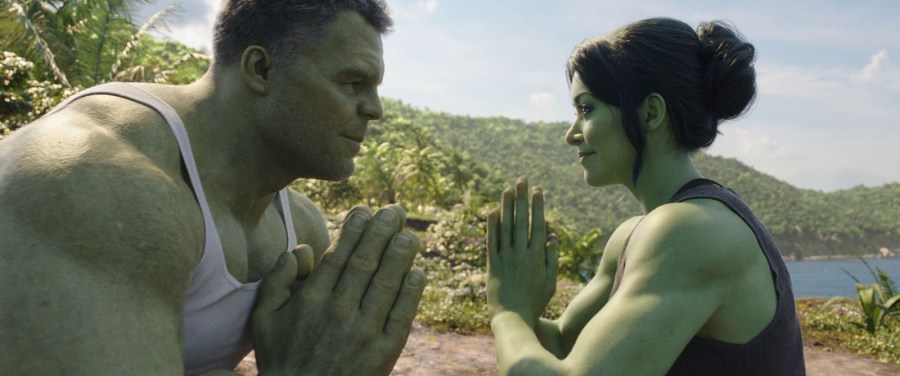
Rating: 3/10
I wanted to like She-Hulk: Attorney at Law. I really did. I love legal procedural TV dramas. I have a thing for Mark Ruffalo, preferably in human non-Hulk form, but still. I have a thing for Tatiana Maslany, preferably in her Helena-from-Orphan–Black form, but still. And I’ve made a point of watching and reviewing more shows written, directed and starring women.
Yet, I don’t know what to make of this latest Marvel Cinematic Universe (MCU) TV show. The nine-episode comedy She-Hulk: Attorney at Law debuts on Disney+ this Thursday, August 18. Maslany stars here as Jennifer Walters, a lawyer in her 30s who also happens to be Bruce Banner’s (Ruffalo) cousin. Jessica Gao (Rick and Morty) serves as head writer and Kat Coiro (Marry Me) directs six of the episodes.
The show makes sure to get some exposition out of the way quickly, showing us how Jennifer Walters turns into the statuesque 6-foot-7-inch version of herself that’s soon dubbed She-Hulk. Her cousin tries to teach her the art of keeping your inner-Hulk at bay. Anger and fear are the triggers, he tells her. “Those are like the baseline of any woman’s existence,” she explains. Bruce doesn’t quite believe that Jennifer has it. But she can control her Hulk version almost immediately, something that took him nearly 15 years. Bruce even has a syllabus on how to Hulk, something his cousin doesn’t really need.
“I’m great at controlling my anger. I do it all the time when I get cat-called on the street or incompetent men explain my own area of expertise to me,” she tells him. This is the way to avoid being called emotional or difficult, she adds, or simply risking getting literally murdered.

I get what She-Hulk: Attorney at Law is trying to do with sequences like that. I share Jennifer’s sentiments and experience. It’s just that the show isn’t subtle — at all. Everything gets spelled out. The series tries incorporating that into its meta-narrative. Jennifer looks at the camera often, breaking the fourth wall and telling the viewer exactly what the writers probably felt the storytelling-savvy audience wanted to hear. “I know you can’t wait to see Wong but this is not one of those cameo-of-the-week types of shows. Except for Bruce and Blonsky — and Wong,” she says at some point.
She means the cameos of previously-seen Marvel characters Bruce Banner, Emil Blonsky a.k.a. Abomination (Tim Roth) and Sorcerer Supreme of the Mystic Arts Wong (Benedict Wong). And there are indeed a ton of cameos, at least in the four episodes of She-Hulk: Attorney at Law made available for review. There are also frequent inside jokes and callbacks about the Avengers’ world at large, which is why I feel that, for a part of the Marvel fandom, this could still be a somewhat compelling watch. There are references to Tony Stark (Robert Downey Jr.) and Captain America (Chris Evans). In case you needed them, you’ll get reassurances that America’s Ass didn’t die a virgin. And you’ll get a glimpse at what Hulk’s next assignment could be.
But other than parading its many superhero connections, the show has problems deciding what it is. On the one hand, it’s a comedy that tries too hard to be funny. It’s also the story of an independent 30-something-year-old lawyer who starts working in the superhuman law division of a firm where she’s expected to always be in Hulk form. We witness a bit of her dating life, reminding us that dating in your 30s is basically the worst. The series also portrays the inner struggle Jen faces as a Hulk. “I didn’t go to law school and rack up six figures in student loans to become a vigilante. That’s for billionaires and narcissists,” she aptly quips. And, on top of all that, She-Hulk attempts a case-of-the-episode structure but doesn’t have much time to add substance to them.

Once again, this is another MCU show — with the exception of the excellent WandaVision and Ms. Marvel, and the notable Loki — that feels like an overstretched origin story with no sense of an efficient TV episode structure. But, more than ever, I had the feeling that this was a show made by committee, and the message they wanted to relay was: “We are feminists at Marvel,” all while moving the storylines of several key Marvel characters forward. Besides its overt feminism, which feels calculated, the show also tries flaunting its queer stripes. It does so when Jennifer’s best friend Nikki (a very underutilized Ginger Gonzaga) takes a look at Jennifer’s dating profile and scorns: “Hetero life is grim.” But that’ll be all the mention of Nikki’s life outside of her work as Jennifer’s paralegal.
It didn’t help She-Hulk: Attorney at Law’s case that Maslany in CGI She-Hulk form looks odd. I’m not dismissing her performance: if there’s someone who can play several characters at once or — in this case — the same character in two very different bodies, it’s her. It’s just that all the CGI involved in her Hulkian transformation doesn’t make her look very believable.
What’s also not great for the show’s overall look is the fact that Attorney at Law is set in Los Angeles but shot in Atlanta, Georgia. Don’t expect many real-life locations to show up here.
Even if I was looking forward to She-Hulk: Attorney at Law — especially after the very enjoyable Ms. Marvel — I feel the biggest takeaway I got from this show is to eat Cheetos with chopsticks to avoid Cheetos fingers, just like Jennifer Walters does.






